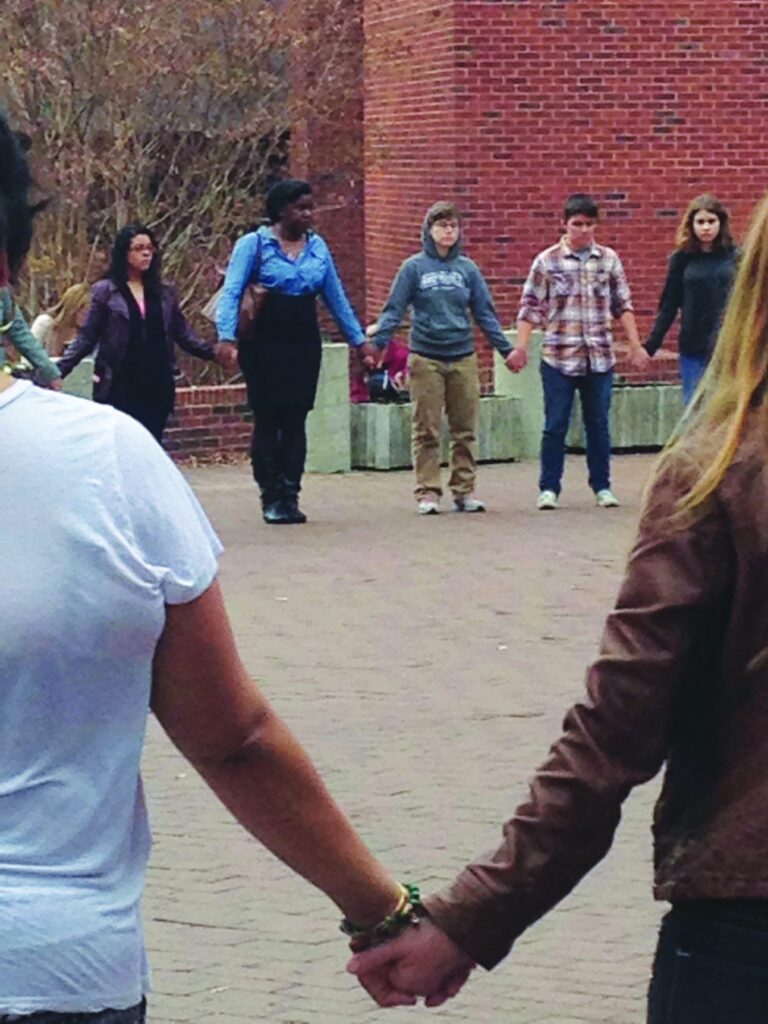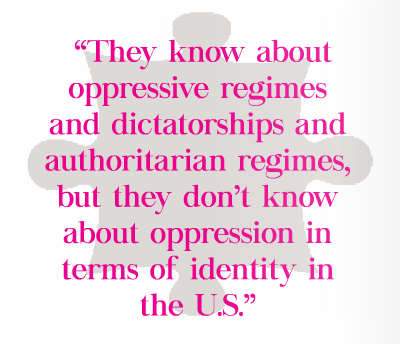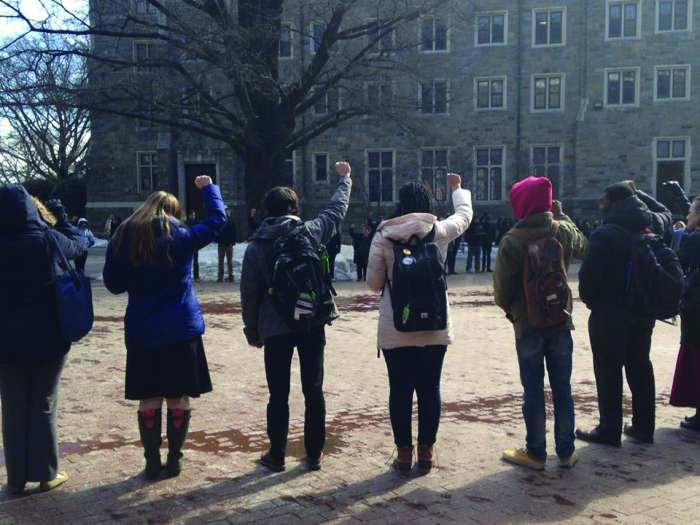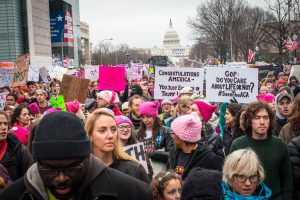On Feb. 7, 2000, 300 students stood crowded together in Red Square. They gathered together in the cold, listening to the voices of their fellow students echoing through the square. They were posed the question “What do we want?” In response, they shouted in unison, “Diversity.”
The Georgetown University Unity Coalition, made up of the Black Student Association, MEChA (a Latin American student group), GU Pride, and the Jewish Student Association, had organized the rally in response to a series of hate crimes that had taken place on campus over the previous months. The incidents included vandalization of a Jewish menorah, spray painting of anti-Semitic graffiti on university property, and continual harassment of gay students. Then-president of the BSA, Erica Cannon (MSB ’02) called the incidents “an epidemic of hate.”
The GUUC rally was far from the first student initiative to press for greater campus diversity. This demonstration came almost ten years after a report released by the Subcommittee on Cultural Diversity in the Curriculum in 1991, marking the first time in Georgetown history that students formally expressed the need for increased awareness of diversity in the university’s academic life. The report read, “To continue to produce leaders in a complex world, Georgetown College must equip its students with a complex understanding of how the world works, now.”
 By 2000, conversations about revising Georgetown’s undergraduate curricula had been underway among students in the background of campus life for years. It was not until 2001, however, that a formal request to implement an academic diversity requirement came to light. The Committee on Diversity in the Undergraduate Curriculum recommended a two-class diversity requirement. According to the report, all undergraduates should be required to take a class entitled “U.S. Pluralism in a Global Context: Interrogating Difference.” The second requirement would be an overlay requirement in which students would take a number of cross-listed courses with subject matter related to issues of diversity.
By 2000, conversations about revising Georgetown’s undergraduate curricula had been underway among students in the background of campus life for years. It was not until 2001, however, that a formal request to implement an academic diversity requirement came to light. The Committee on Diversity in the Undergraduate Curriculum recommended a two-class diversity requirement. According to the report, all undergraduates should be required to take a class entitled “U.S. Pluralism in a Global Context: Interrogating Difference.” The second requirement would be an overlay requirement in which students would take a number of cross-listed courses with subject matter related to issues of diversity.
The committee’s proposal, however, was rejected by the College Curriculum Committee in 2002. The faculty and deans who formed the CCC argued that adding a mandatory class about U.S. pluralism would overwhelm the instructional capacity of the Department of American Studies. The committee also expressed the belief that Georgetown’s curriculum already naturally incorporated issues of diversity, making an additional diversity requirement redundant. “It would be almost impossible to obtain a Georgetown degree without having engaged in at least some classes which explicitly dealt with issues of pluralism,” the CCC wrote.
Associate Dean Dennis Williams, who served as the Director of the Center for Multicultural Equity and Access from 1997 until 2014, said that he was surprised that the proposal was rejected in 2002 due to the strong student support in favor of the requirement and the popularity of diversity requirements at Georgetown’s peer institutions. A poll conducted by a student diversity committee in 1999 found that 52 percent of students believed that Georgetown’s curricula did not adequately address diversity. Additionally, a survey of 543 universities, including many of Georgetown’s peer institutions, found that, in 2000, 62 percent of universities had some form of a diversity requirement in their curricula, and over half of these institutions had instituted the requirement over five years prior to the survey.
Williams explains the rejection as a type of institutional inertia. “Our faculty is not very forward-thinking on these issues,” he said. “We at Georgetown give ourselves a lot of credit for what we have, and if it’s different than what other people have, we just assume that we’re special.”
After the CDUC’s proposal was rejected, a lull in student activism on the issue ensued. While the university enacted other diversity initiatives, such as creating the African American Studies minor in 2003, it was not until 2007 that renewed efforts to create a diversity requirement surfaced. African American Studies program professors Michael Dyson and Soyica Colbert and Department Chair Robert Patterson did not respond to multiple requests for an interview with the Voice.
 In 2007, the Georgetown Student Commission for Unity published an external report, showing that, in terms of diversity, Georgetown ranked far below many other top universities. The group entered negotiations with the president’s office, and these negotiations resulted in the President’s Diversity Initiative in 2009. The Initiative created three working groups: the Academic Working Group, the Admissions and Recruitment Working Group, and the Student Life Working group. Among the groups’ suggestions to improve different areas of campus diversity, the Academic Working Group included a curricular diversity requirement in its final report released in 2009. Professors Eusebio Mujal-Leon and Veronica Salles-Reese, who chaired the Academic Working Group in 2009, were unavailable for comment on this story.
In 2007, the Georgetown Student Commission for Unity published an external report, showing that, in terms of diversity, Georgetown ranked far below many other top universities. The group entered negotiations with the president’s office, and these negotiations resulted in the President’s Diversity Initiative in 2009. The Initiative created three working groups: the Academic Working Group, the Admissions and Recruitment Working Group, and the Student Life Working group. Among the groups’ suggestions to improve different areas of campus diversity, the Academic Working Group included a curricular diversity requirement in its final report released in 2009. Professors Eusebio Mujal-Leon and Veronica Salles-Reese, who chaired the Academic Working Group in 2009, were unavailable for comment on this story.
Interim Dean of the SFS James Reardon-Anderson said that the proposed requirement has not succeeded for so long because changing the core curriculum of any university is a slow process, regardless of the nature of the proposal. Since 1991, Georgetown University made one change to its core curriculum when it altered the Humanities and Writing requirement in 2013. Additionally, Reardon-Anderson said that most faculty members resist adding additional requirements to the curricula because they believe that they restrict students’ academic freedom.
Williams attributes the cyclical nature of diversity movements at Georgetown to the exhaustive nature of student and faculty activism. “You almost can’t do this constantly and do your job,” he said. “People collect their energy and make a push, but when it fails you fall back and take a breath. It’s frustrating and disappointing.”
On Monday, Feb. 23, 2015, 15 years after GUUC’s efforts and 25 years after the release of the SCDC’s original recommendation for a diversity requirement, a familiar scene unfolded in Red Square. In the wake of a cartoon published by the Voice depicting violence against a black student and a female student by two white students, students stood in a circle with their hands raised in solidarity. Once again, they called for greater understanding of diversity on campus. “How are you supposed to be men and women for others when you don’t know who the others are?” Kimberly Blair (COL ’15), an organizer of the rally, asked at a town hall held in response to the Voice’s cartoon.
This rise in student support for creating discussions centered around diversity accompanies a proposal co-authored by the Last Campaign for Academic Reform and the Provost’s Office’s Diversity Working Group to implement an “Engaging Difference” requirement. The current movement proposes an overlay requirement that would mandate undergraduates to take two classes that focus on some aspect of diversity. The proposal’s definition of diversity is far-reaching, encompassing not only issues of race and class, but also those of gender, sexual orientation, and ability.
The authors of the proposal, who, according to LCAR member Dan Zager (COL ’18), had been working on the proposal privately since December, decided to publicize their proposal and circulate an online petition during the height of student outrage over the Voice’s cartoon in order to garner student support for their efforts.
The decision to pass or reject the proposed requirement will be made solely by the Main Campus Executive Faculty, who will vote on the proposal on March 27. Zager believes that student support from the petition may influence faculty to support the proposal. “To show that this is a campus-wide initiative will help get this passed,” Zager said.
The Engaging Difference requirement has its roots in the annual Black House President’s Dinner that took place in the spring of 2014. At the dinner, members of the Black House, a Georgetown residence dedicated to fostering a community for students of color, presented an eight-point proposal to university President John DeGioia, which included a request for a diversity requirement and the creation of a Provost’s Committee on Diversity.
The university has since responded to some of the points mentioned by the proposal. Most notably, the Provost’s Committee on Diversity came into fruition in February of this year. Vice Provost Randall Bass, who was involved with the Diversity Working Group, hopes that, as it takes shape, the PCD will play a role in guiding the implementation of the Engaging Difference requirement and in ensuring that it will have the most meaningful effect possible for students.
“There will always be a mismatch between a course requirement and the larger effect,” Bass said. “We as a university have the obligation to introduce our students in a responsible way to the most difficult issues of our time.”
Resident Director of the Black House Nancy Hinojos (MSB ’15), said that asking the university to implement a diversity requirement is a difficult but necessary task. “This [requirement] will be a good way to talk about issues that can be uncomfortable and, yes, they can be hard to talk about, but it’s critical for us to understand these issues,” Hinojos said.
Nevertheless, some members of the campus community have expressed concern about the implementation of the “Engaging Diversity” requirement. Supporters of the proposal say that, although they have not encountered much ideological opposition to the idea of a diversity requirement, faculty and students are most frequently concerned with the logistics of implementing such a requirement.
Reardon-Anderson said that the SFS core curriculum is already requirement-heavy and adding another requirement could be too restrictive for  students. “Universities should give students the opportunity to explore,” Reardon-Anderson said. “I think sometimes the curriculum becomes too restrictive.”
students. “Universities should give students the opportunity to explore,” Reardon-Anderson said. “I think sometimes the curriculum becomes too restrictive.”
He also said that, while diversity should be discussed in many different classes throughout Georgetown, a requirement could be detrimental if it pushes students to think a certain way about diversity. “We should raise issues of divisions of power, privilege in the classroom, but I don’t think the curriculum should instruct people on what to think,” Reardon-Anderson said.
Additionally, speaking from his knowledge of the Walsh School of Foreign Service curriculum, Reardon-Anderson said that a diversity requirement may be redundant, given the existing core requirements of the SFS. “The whole of the SFS curriculum is a diversity curriculum,” he said. “It’s hard for me to see what is not diverse about our [the SFS’] curriculum.”
Elizabeth Oh (SFS ’16), however, said that, even though the SFS does focus on cultural differences, a diversity requirement would still be beneficial to SFS students because they do not currently learn about diversity as it applies to the context of the United States. “I have a lot of friends in the SFS who understand why Brazilians are racist to each other, but don’t understand why people in Ferguson are rioting,” she said. “They know about oppressive regimes and dictatorships and authoritarian regimes, but they don’t know about oppression in terms of identity in the U.S.”
LCAR and the Diversity Working Group have pursued active dialogue with faculty and students about the terms of the requirement to ensure that it, if passed, will be a meaningful addition to undergraduates’ academic experiences, while still not overburdening students’ course load. As such, they have compiled a list of about 80 courses currently taught at Georgetown that could be cross-listed to satisfy both the diversity requirement and another general education requirement. Bass called the requirement a “win-win,” saying that the overlay requirement would strike a good balance for student academic life.
Although a diversity requirement remains absent from Georgetown’s curricula, the campus has undertaken several notable diversity initiatives in recent years both in academic and extracurricular life. The LGBTQ Resource Center was founded in 2008, marking a huge step forward for the LGBTQ community on campus. Following the President’s Diversity Initiative in 2009, the African American Studies program was expanded and hired additional faculty members. At the recommendation of the Student Life Working Group, the resident assistant training also includes intensive training on race, gender, sexual orientation, age, religion, ability, and socioeconomic status. Director of Residential Living Ed Gilhool did not respond to the Voice’s request for comment.
Students view these and other developments as progress, but they say that these initiatives do not have the capacity to reach all students. “It’s sort of the same students who show up to all the events,” Hinojos said.
 Colleen Roberts (COL ’15), a supporter of the diversity requirement, believe
Colleen Roberts (COL ’15), a supporter of the diversity requirement, believe
s that all students need to be educated on issues of diversity in order to understand the world. “Its really important for all student to be dabbling in these issues, not only the students who self-select for it,” she said.
“I am so tired of having to explain why I am advocating for a diversity requirement,” Oh added. “There is so much explaining that students have to do that it’s exhausting selling our identity. There is no incentive or requirement in our school to learn.”
With the faculty vote one week away, supporters of the requirement remain hopeful. After 25 years of ongoing committees, working groups, and proposals, Zager believes that they have finally struck the right balance. “I am confident that this group of students and faculty will pass the requirement,” he said.
Even if the requirement does not pass its supporters, like Hinojos, have no plans to give up. “The idea is to continue supporting and advocating for a diversity requirement.”
Additional reporting by Ryan Greene





